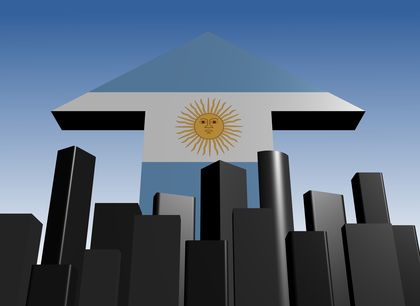Argentina - Overview of economy

Argentina's economy is one of the richest and most diversified in Latin America. The nation has a variety of natural and other resources which have combined to produce an economy that is based on a strong industrial base, an export-oriented agricultural sector, and a growing service sector. The Argentine population is highly educated and skilled, and the country has a variety of natural resources including lead, zinc, copper, iron petroleum, uranium, and rich agricultural areas. However, after repeated periods of military dictatorship, the nation faced a variety of economic problems when the first sustained period of civilian control of the government began in 1983. By 1989, the nation had an enormous external debt , and inflation had reached a level of 200 percent per month. In response, the government undertook a variety of programs to reform and reinvigorate the economy. In 1991, it initiated a series of programs which provided a fixed exchange rate between the peso and the U.S. dollar and ultimately reformed the banking system. This dramatically lowered inflation and helped stabilize the economy. The government in 2001 continued an economic program which raised taxes and cut government spending in an effort to lower the nation's budget deficit and overall debt.
Argentina underwent an economic boom period in the early 1990s. By 1997, GDP growth had reached 8 percent per year. Reforms in the economy led to increased competition and output. These reforms also attracted significant new foreign investment. Between 1992 and 1999, exports more than doubled from US$12 billion to US$25 billion. In overall terms, international trade remains only a small part of the Argentine economy. In 1995 Argentina, Brazil, Chile, and Uruguay created a free trade area named MERCOSUR. The trade organization has dramatically lowered tariffs between the member nations with reductions in some tariffs of 100 percent. As a result, trade between the member states increased from US$4 billion in 1991 to US$23 billion in 1999. Argentina accounts for 27 percent of MERCOSUR's total GDP. Brazil is now Argentina's largest trading partner. Argentina's exports to MERCOSUR countries are expected to continue to increase and to help spur the economy.
In 1998, the nation began a severe recession that ended in 2000. In 1999, GDP fell by 3 percent, but by 2000 growth had returned at a 2 percent annual rate. However, unemployment in the nation continues to be problematic. Unemployment peaked in 1995 at 18.4 percent. Although it has fallen, it remained at 15.4 percent as of 2000. Increases in productivity and reforms of the labor market are expected to decrease unemployment as more foreign investors locate or relocate firms and factories in Argentina.
The strongest areas of the Argentine economy are telecommunications, food processing, banking, energy production, and mining. Food processing alone accounted for 23 percent of GDP in industry in 1998 and is one of the few areas in which Argentina has a trade surplus . The nation's large agricultural sector produces a variety of products that are used by domestic food industries and then exported. Agriculture provides about 40 percent of Argentine exports. Besides food processing, Argentina's main industries are automobile production, textiles, chemicals and petrochemicals, steel, mining, and consumer durables. After falling by 7 percent in 1999, industrial production recovered slightly in 2000, with a modest growth of 2 percent. Many major international car manufacturers have plants in Argentina, including Ford, Volkswagen, Fiat, General Motors, and Renault. Mining production is expected to double by 2004, with strong growth in gold and copper production. The Argentine telecommunications sector was one of the first in Latin American to be privatized . Since 1991, the sector has experienced continued growth as consumers have sought new technologies, including cellular phones, pagers, and cable television. Reforms in 1994 eliminated restrictions on foreign-owned banks, and insurance firms and many multinational financial companies operate in Argentina. Some of the larger firms include the U.S.-owned American Express Bank, Citibank, Chase Manhattan, Bank Boston, the Dutch-owned ABN Amro Bank, and the British-owned Lloyds Bank.
Argentina continues to face yearly deficits—US$4 billion or 2.5 percent of GDP in 1999 alone. In 1999, the country's debt was US$149 billion. However, Argentina is a net recipient of foreign aid. It receives about US$2 billion a year from international organizations such as the European Union (EU) and the World Bank. In 1999, the International Monetary Fund (IMF) established a contingency fund of US$7.4 billion that can be loaned to Argentina in order to maintain the nation's currency and economic stability.
Comment about this article, ask questions, or add new information about this topic: